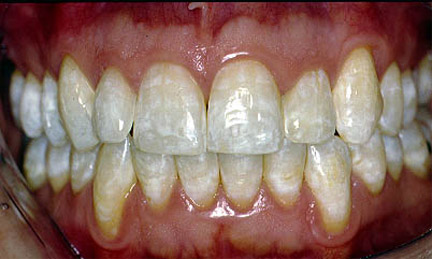What is dental fluorosis?

Moderate to Severe Enamel Fluorosis….
Dental fluorosis, also called mottling of tooth enamel, is a developmental disturbance of dental enamel caused by excessive exposure concentrations of fluoride during tooth development. The risk of fluoride overexposure occurs at any age but it is higher at younger ages. In its mild forms (which are its most common), fluorosis often appears as unnoticeable, tiny white streaks or specks in the enamel of the tooth. In its most severe form, tooth appearance is marred by discoloration or brown markings (mottling). Fluoridated water alone is not likely to cause any noticeable enamel changes. The enamel may be pitted, rough and hard to clean but is resistant to dental decay and disease.
Physiology
Teeth are generally composed of hydroxyapatite and carbonated hydroxyapatite; fluoride replaces the hydroxyl in hydroxyapatite forming fluorapatite. Excessive fluoride can cause white spots and, in severe cases, brown stains, pitting, or mottling of the enamel. A tooth is no longer at risk of fluorosis after eruption into the oral cavity. At this point, fluorapatite is beneficial because it is more resistant to dissolution by acids (demineralization). Although fluorosis usually affects permanent teeth, occasionally the primary (baby teeth) may be involved.
Risk factors for dental fluorosis
The greatest concern in dental fluorosis is effects it has on the appearance of the permanent dentition (the adult teeth). These changes are prone to occur in children who are excessively exposed to fluoride between 20 and 30 months of age. The critical period of exposure is between 1 and 4 years old, and the child is no longer at risk after 8 years of age. The severity of dental fluorosis depends on the amount of fluoride exposure, the age of the child, individual response, weight, degree of physical activity, nutrition, and bone growth.
Many well-known sources of fluoride may contribute to overexposure including toothpaste/fluoridated mouthrinse (which young children may swallow), bottled waters which are not tested for their fluoride content, inappropriate use of fluoride supplements, ingestion of foods especially imported from other countries, and public water flouridation. The last of these sources is directly or indirectly responsible for 40% of all fluorosis, but the resulting effect due to water fluoridation is largely and typically aesthetic. Severe cases can be caused by exposure to water that is naturally fluoridated to levels well above the recommended levels, or by exposure to other fluoride sources such as brick tea (chinese tea) or pollution from high fluoride coal.









